Tom & Jerry: The Chuck Jones Collection
by Ben | July 3, 2009 11:39 am
MGM/Tower 12 Productions (1963-1967), Warner Home Video (June 23 2009), 2 discs, 216 mins plus supplements, 1.78:1 anamorphic widescreen, Dolby Digital Mono, Not Rated (nothing offensive, but package notes the title is “intended for the adult collector”), Retail: $26.98
Storyboard:
The famed cat and mouse team return in an underrated series of further cartoons supervised by legendary Looney Tunes director Chuck Jones.
The Sweatbox Review:
The very first Tom & Jerry cartoon, Puss Gets The Boot, arrived on theatrical screens in 1940, and came so early in creators Bill Hanna and Joe Barbera’s MGM careers that it was labelled as a Rudolf Ising production. Hanna and Barbera had been at the MGM studio by this time for a few years, and had already produced a number of stand-alone shorts. Puss Gets The Boot was to be one just like any other – neither character is actually named as we know them, the cat being called “Jasper” and with a distinctly more tabby appearance, while the mouse already had the features that we recognise as Jerry (in fact, he would be the character who, over the years, changed least). The breakout success of the film and the pressure from distributors for more cat and mouse war meant the development of the series, and a battle of wits that would last for decades!
Nominated for an Academy Award, Puss Gets The Boot was the first of a number of such nominations for the duo (they would actually win seven awards for Best Short Subject), while Hanna-Barbera also bagged a few more nominations and wins for other cartoons made for MGM. When Walt Disney refused MGM’s use of Mickey Mouse to appear opposite Gene Kelly in the 1945 musical Anchors Aweigh (despite Disney’s mouse appearing in MGM’s 1934 feature Hollywood Party alongside Jimmy Durante), Hanna-Barbera stepped in and offered Jerry instead. And they ventured into live-action musical pictures again almost a decade later when they met up with swimming sensation Esther Williams in the 1953 feature Dangerous When Wet. When long-time MGM animation producer Fred Quimby (a man not known for his sense of humor, he once commented during a screening of a Tex Avery short that he “did not understand what was going on”) announcing his retirement, Bill and Joe were promoted to his position, also working with Kelly again on the half-hour animated sequence from the much too rarely seen feature Invitation To The Dance (1956).
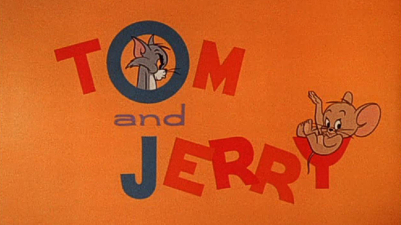
But then the tides changed, and soon after Quimby’s departure, MGM decided to halt production on the cartoons completely, mainly as the revenues had begun to dry up and any demand for short subjects could be met with back-catalog reissues of old cartoons instead of producing new ones, Hanna-Barbera found themselves released from their Studio contract (giving them the opportunity to set up their own facility for creating animation exclusively for the new television medium and enter the history books). With MGM having shut down their animation department and thinking that older, catalog shorts could generate just as much revenue as new cartoons, they soon found that there was still much demand for freshly created films from theater exhibitors, who actually – and rightfully – balked at paying good money for the same product twice. But now that Bill Hanna and Joe Barbera had left to begin their prolific television output, the Studio decided a cheap way of continuing the cartoons without the need to actually run a cartoon unit was to lease the characters to Czech animator/director Gene Deitch, who created a short-lived series of such lacklustre shorts that they were all but disowned by the company.
Around this time, and with the concurrent closure of the Warner Brothers cartoon outfit, Looney Tunes director Chuck Jones had set himself up in business as Tower 12 Productions, and MGM tapped the director with the proposition of redesigning their famous cat and mouse duo for a re-vamped series. Jones, of course, had risen to prominence at WB almost in parallel to Hanna-Barbera’s work at MGM, as one of the cartoon unit’s most imaginative directors, often taking Bugs, Daffy and company off in wild directions. Perhaps most satisfied with the endless configurations that he and his team came up with for the Road Runner/Coyote cartoons, Jones accepted the not so easy task of taking on the cat and mouse, redefining their personalities in a similar type light. Their characteristic visual appearance also changed a little to reflect the wry look Jones fans will recognise from such characters as Wile E Coyote and Pepe Le Pew. The cartoons were only moderately successful, but did the job of keeping Tom & Jerry in the public eye, even if nowadays this series has been very rarely seen. That’s a shame, as some of these cartoons contain really good gags and develop the characters beyond the simple chase genre that gave the H-B cartoons their spark.
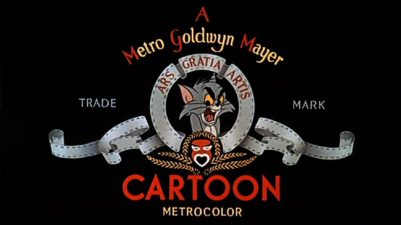
Here Tom and Jerry are more mischievous, with careful plotting taking the place of a quick and painful revenge. Tom is certainly the Coyote of the pair, while Jerry is more self-satisfied, perhaps unworried after years of foiling the cat that he could ever get caught. There’s also an undercurrent of Jones’ often used slow-burn as opposed to the whacking and thwacking of the earlier efforts. Certainly, these cartoons are of their time, the mid-1960s, but within that range there were also some new things brought to the shorts, such as the idea of spoofing popular trends and other films, which was a popular movie concept at the time when the comic Cat Balloo aped epic westerns and In Like Flint was the Austin Powers of its day, turning the James Bond phenomenon on its head. Jones was always at the forefront of animated parody, and indeed kept this up through this series.
Now recompiled for DVD following a near 20-year old LaserDisc anthology set, we kick off as before with Pent-House Mouse (1963), and immediately noticeable is that one remaining element that has not changed in the Jones shorts is Scott Bradley’s unmistakable theme (though actual scoring duties would be taken over by Eugene Poddany). Over the years this theme has accompanied Tom & Jerry’s many title card picture switches (the biggest swap came with the jump to CinemaScope) and here they now have an entire animated sequence that opens each film, with Tom replacing Leo, the celebrated lion in the MGM logo, sniffing and growling as best he can, while Jerry floats down and plumps himself cosily on top of his name, sliding into the final letter like it was a cocktail glass. It’s a great opening and firmly sets this series up as something new.

Jones kept many of his Warner Brothers associates on with him at Tower 12, including storyman Michael Maltese, designer/co-director Maurice Noble, animator Ken Harris, director Abe Levitow and voice artists June Foray and, of course, Mel Blanc (although T&J still rarely speak in these films). Pent-House Mouse looks and feels like a 1950s Warner Bros cartoon, in particular One Froggy Evening. We find Tom lazing about in his stylish top-floor apartment, acting very suave in typical Chuck Jones fashion. Poor Jerry on the other hand, is desperate for food, so when he spots a workman’s lunch on a nearby construction site, he tucks in. Unknown to Jerry, the lunch pack gets towed up on a beam destined for the top of the high rise, but it falls off, landing on Tom’s head. And so begins the battle between Jones’ take on Tom and Jerry…
With 1964’s The Cat Above And The Mouse Below (mis-titled on the disc’s menu), Jones invokes his taste for classical music when “Thomasino CattiCazzaza” attempts to sing the Rigoletto to a packed house, not realising that Jerry is trying to sleep beneath the stage (the cartoon also recalls the earlier 1949 WB short Long Haired Hare). Is There A Doctor In The Mouse? features some great gags when Jerry concocts a potion that gives him super fast speed and Tom tries to catch him on film – the “slow-mo” replay with the action all mapped out is a very funny touch. A Spike replacement (looking very much like a certain canine from the WB films) appears in Much Ado About Mousing, Jones’ first beach-set short, in which Jerry is protected from Tom’s fishing by the dog, who gives him a whistle to blow if he gets into trouble – a very similar set up to the earlier Hanna-Barbera short Fit To Be Tied.
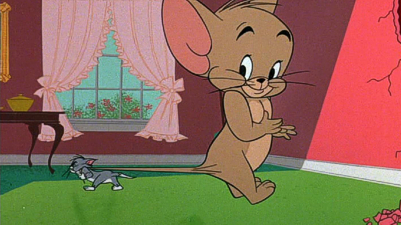
Snowbody Loves Me (which has the most random “what the?” ending to any T&J cartoon) also returns to the basic H-B formula: stuck outside in the cold, Jerry tries every trick in the book to get in and munch on the Swiss cheese that Tom has inside, while The Unshrinkable Jerry Mouse has Jerry protecting a little kitten from Tom. It’s cartoons like these that reinforce the view that the more things change, the more they stay the same, and although Poddany’s scores don’t play with including recognisable themes as much as Bradley used to (he has a tendency to strongly “Mickey Mouse” the action), these films are still Tom & Jerry in look and feel. Ah, Sweet Mouse-Story Of Life (1965) is another short that demonstrates Jones’ ability to provide new visual twists on older gags, and so keeping the tradition of the series going.
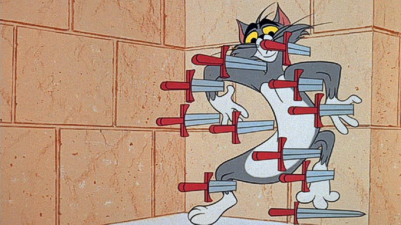
Tom-Ic Energy (don’t you just love these title puns?) follows the previous cartoon’s taking T&J out of the house and placing them in the big city to continue their chase, with all that that entails, but retains a cosy familiarity. Animation conventions are brilliantly played with in Bad Day At Cat Rock, which returns us to the building construction site for some more clever visual tricks, and The Brothers Carry-Mouse-Off has Tom donning a mouse disguise so as to get closer to Jerry in another film that retains the atmosphere of the H-B shorts, though this one was only produced by Jones, being directed instead by storyman Jim Pabian. In Haunted Mouse, things get a little more inventive when Jerry’s magician mouse cousin (another one!?) comes to stay. Obviously Tom mistakes the trickster for Jerry, leading to some comic complications when the mouse conjures up a group of rabbits to mystify Tom. A fun diversion, this short isn’t the most densely plotted of Jones’ films, and fills out some extra seconds at the end by having the final title appear, for no other apparent reason, in several different languages!
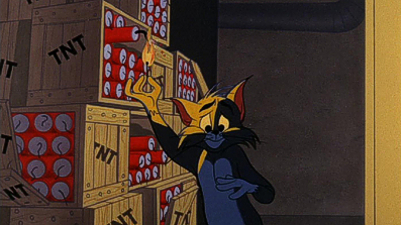
I’m Just Wild About Jerry reminds very much of the type of gag that Jones would use in his earlier Road Runner chase cartoons. One recurring joke in particular will stand out to fans of the Coyote: on chasing the mouse on roller skates, Tom’s journey eventually comes to a halt on a set of railway tracks – just in time to get a front seat view of the train’s headlights running straight for him! Of Feline Bondage plays with the old H-B idea of invisibility as seen in their earlier films The Invisible Mouse and The Vanishing Duck. This time around, Jerry’s fairy Godmouse takes pity on the poor little rodent after one too many beatings from Tom and gives him a potion that makes him disappear. You can imagine what comes next, though Jones’ slightly tamer direction means that some of the gags do not play off so well as those in the earlier versions, and the animation seems to make the objects come to life themselves, as opposed to the clever way the H-B cartoons really made the audience feel that they were still really “seeing” Jerry in a scene.

1965’s helpings finish off with The Year Of The Mouse (Jerry and friend convince Tom that he’s a nut, only to get their own comeuppance in the end), and The Cat’s Me-Ouch, featuring a tiny but dangerous mouse-sized bulldog. 1966 would prove to be Chuck’s major year with the cat and mouse, producing or directing eleven cartoons in the series. Duel Personality has an entire “pre-credits” sequence, leading to a very funny short in which the weapons of choice grow larger and more lethal as the film progresses! This one is also noteworthy for the fact that scoring duties are taken over by Dean Elliott who, while retaining Bradley’s theme in the openings, tries to bring some new recurring musical motifs to the series. Finally, the little mouse attacks Tom in his sleepwalking state in Jerry, Jerry, Quite Contrary, in the last of the first platter’s helping of shorts.

Onto the second disc, and we skip out of sequence back to 1965 for Jerry-Go-Round, set in a circus and directed by Abe Levitow (though the “stop-start” nature of the opening titles is pure Jones), while in Love Me, Love My Mouse, Jones is joined in directing by Ben Washam. The two fashion perhaps the most surreal cartoon in the collection, with backgrounds reminiscent of What’s Up, Doc? as Tom literally floats over to his sweetheart to propose – only to have her take pity on Jerry! Puss ‘N’ Boats, directed again by Levitow, is another ship-set cartoon, with Tom not only after Jerry, but also having to save himself from a hungry shark! Over the course of the cartoons, one can see that Jones was itching to progress to other projects, if only from reading his involvement in the credits themselves. He had already began to share direction with others on his crew, most notably Abe Levitow, and the cartoons began to hark back to the H-B films in story as well as theme as the ideas seemingly dried up. This becomes most apparent with the remainder of the shorts which, while not straight remakes, recycle many elements from earlier cartoons.
In Filet Meow, Jerry befriends and saves from Tom a little goldfish (a similar concept to the aptly named Jerry And The Goldfish from 1951), and Matinee Mouse, directed by Tom Ray, becomes the first “highlights” cartoon in this collection, being made up of clips from Love That Pup and Jerry’s Diary (itself a compilation) from 1949, The Truce Hurts (1948), The Flying Cat (1952) and The Flying Sorceress from 1956. Hanna and Barbera are quite rightly given due credit, but it’s a little odd to see these clips re-scored and with new sound effects, though the concept of T&J going to a movie house to see their old films works well enough, even if the theater does show one of the CinemaScope cartoons in a pan-and-scan version!
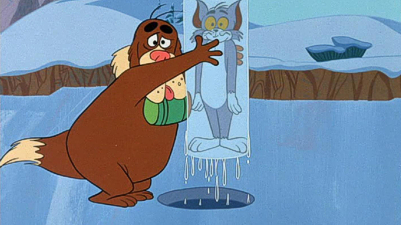
Levitow’s The A-Tom-Inable Snowman is an Alps set chase, featuring a really fun co-starring St Bernard who comes to Tom’s aid with a beverage or two when Jerry gets the better of him. Jerry pits Tom’s wits against another cat in Catty-Cornered (another Levitow short, but scored this time by yet another composer, Carl Brandt), and the same cat joins Tom again to fight over Jerry in Cat And Dupli-Cat, this time directed by Chuck himself, who might have been attracted to the musical theme of the short, with Eugene Poddany back as composer.
As Jones spent more and more time on other projects, he only contributed some gags and a producer role to these remaining cartoons in the series. Now mostly directed by Abe Levitow, they are a mixture of “tried and tested” routines and the “outrageously desperate”. Two films that smack of this are O-Solar-Meow, which places T&J on a space station of all things, and Guided Mouse-Ille (or, Science On A Wet Afternoon), where another set of high-tech gadgets play their part in the ensuing violence. There is nothing actually wrong with either of these two films, and they are very funny cartoons in their own right, but just do not feel like the traditional Tom & Jerry we’ve come to expect from Hanna-Barbera or even Jones, though the Solar short does predate 2001: A Space Odyssey in some ways and also Star Wars by over ten years! The 2565-set Guided film also has some neat ideas, but there is something comforting about seeing T&J smashing the heck out of each other in a normal home environment that doesn’t quite work when they are substituted by futuristic robot version of themselves doing essentially the same thing.
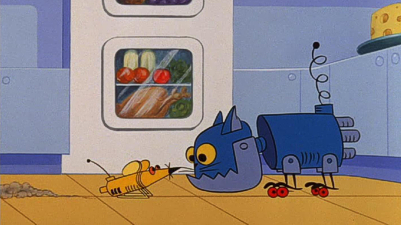
Perhaps one of the most seen of these particular Chuck Jones films is Rock ‘N’ Rodent, which kicks off the final few cartoons, from 1967. Directed by Levitow, it sets up that old chestnut where all Tom wants is a quiet night’s sleep, only to find that Jerry’s jazz band concert is being held in Tom’s basement. Cannery Rodent (great title!) is another seafront set toon, directed by Chuck, and basically works as a continuation of the earlier Cat And Dupli-Cat, with a similar shark still pursuing Tom. Spoofing the hit television show The Man From U.N.C.L.E. is Levitow’s The Mouse From H.U.N.G.E.R. – which if not the all time best cartoon in this set, is most certainly one of the most re-watchable. The short has plenty of fun with spy-film conventions, setting up Tom as an ultimate agent from an Evil Enemy Agency. With more pace and sheer “zip” than many of the other Jones cartoons, this one is simply great fun, with Dean Elliott’s score easily bringing the U.N.C.L.E. theme to mind (that show was produced by MGM’s live-action division) and providing a smile of its own!
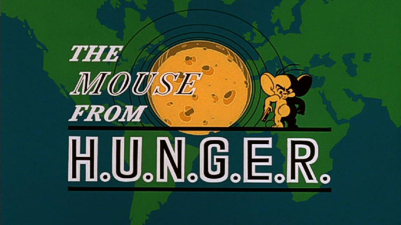
Levitow’s Surf-Bored Cat is set back on the beach, where T&J’s attempts to catch a wave are foiled by each other – not to mention an annoying octopus and that hungry shark back for more. Although we’ve seen this situation countless times before, this is probably the best of Chuck’s sea/beach films. Jumping out of order again, we come to the series’ natural end with Shutter Bugged Cat, a final “highlights” short (directed again by Tom Ray) that allows another look back through the concept of the duo checking through old film footage. Interestingly, the Jones team did not include any of their own recent offerings, relying instead on clips from the Oscar winning H-B directed Yankee Doodle Mouse (1943), Heavenly Puss (1949) and Designs On Jerry (1955), integrating them rather well with their new animation.
Though it is not known if it was intentional or not, it does feel right to end the series with a film containing footage from the Yankee Doodle short as this was an early highlight itself, being the first Academy Award winning T&J film, and somehow brings everything around full circle even if, as before, watching these classics with Dean Elliott’s new music does feel a little uneven. Ben Washam’s Advance And Be-Mechanized takes us, as the original LaserDisc’s liner notes said, “back to the future” where Tom’s “robot-cat” receives another beating from Jerry’s mechanical mouse, in another cartoon that, despite its futuristic setting somehow feels among the most dated among this collection. Lastly in this set, Purr-Chance To Dream, directed by Washam, sees the return of Jerry’s mouse-sized pet pooch and to all intents and purposes is a sequel to The Cat’s Me-Ouch.
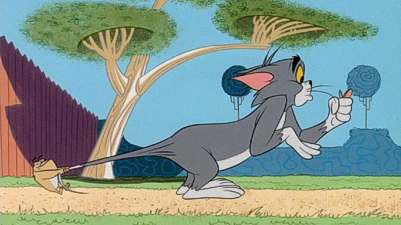
Eventually, Chuck Jones’ Tower 12 was bought out by MGM and was re-branded as their own in-house animation production facility, MGM Visual Arts. After these Tom & Jerry cartoons ran out of steam, Jones developed his own ideas, winning an Oscar for his classic The Dot And The Line, as well as several collaborations with the UPA Studio (he had already written the feature Gay Purr-ee for them in 1962). At MGM, he created the highly successful TV specials How The Grinch Stole Christmas (1966) and Horton Hears A Who (1970), leading to his writing and co-directing the animated feature The Phantom Tollbooth, also in 1970. This feature would unfortunately do nothing to lift MGM’s ailing fortunes (the rest of the company was in a bad shape as well) and the Studio decided to permanently close down the animation department and cease all animation production for good.
For many, the magic of the Tom & Jerry shorts ended when Joe Barbera and Bill Hanna left the studio. While that is not entirely fair on these Jones films, it has to be said that theirs are the shorts and attitudes we think of when we see “A Tom & Jerry Cartoon” blaze upon the screen. Jones’ reinvention of the characters revitalised them for the time, but now remain slightly obscured by the renaissance of the original cartoons. Personally, I like the Chuck Jones shorts. I think they often feel more contemporary and fresh than some of the routine “beat ’em ups” of the H-B period, and certainly provide the kind of entertainment value and loyalty to the characters that was sorely missing from later television attempts and especially the lazy, flat and drab 1990s movie version or the insipid Tom And Jerry Kids project. For any cat and mouse fans out there, these shorts are more than just an interesting curio, being a highly unique peek at one director’s take on other creators’ long-standing characters which, while never in danger of eclipsing the originals, do succeed in their own right.
Is This Thing Loaded?
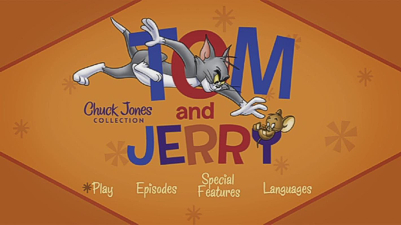
Although these particular cartoons have been long in making the jump from LD to DVD, the wait has been worth it, with WB’s usual attention to their priority titles meaning that The Chuck Jones Collection arrives with all the importance it should have. Trailers for other Warners animated titles kick off the first disc, including previews for the Peanuts: 1960s Collection, Saturday Morning Cartoons 1960s and 1970s collections, plus a trail for Tom & Jerry’s Greatest Chases, from their Hanna-Barbera days, as its own option. The main menu goes that frustrating route of calling these short films “episodes” on both the main screen and the individual selections, when these shorts were theatrical outings and not television shows, even if they were later shown that way.
The primary focus on this disc is the new featurette Tom And Jerry…And Chuck, wonderfully narrated by a totally appropriate June Foray. This 20 minute piece delves into a bit of the MGM backstory to deliver the message of just how important their animated cat and mouse were to the Studio, and sets up Jones as the maverick director making waves over at rivals Warner Bros. during the same era. The coming of television and the reasons behind the closing of the Studios’ animation units is examined, and even the Gene Deitch cartoons are touched upon, and for a while I felt like I was watching a visual interpretation of the beginning of this very review! In archival interview material, Chuck elaborates on the Tom & Jerry series as he saw it from Hanna-Barbera, and their jumping to the limited animation of their TV output, while he explains how he preferred to hang in there on theatrical product with some welcome and rather frank comments.

With WB owning most if not all of MGM and Chuck’s productions, Tom And Jerry…And Chuck is able to sample it all to maximum effect, piling in clip after clip to explain the cartoons’ visual styling, Chuck’s new but familiar directions and their influences, particularly some of Hanna-Barbera’s previous cartoons and Chuck’ own Looney Tunes work. It’s a really generous featurette, a mini-documentary of its own really, where only one “glitch”, some audio archive of Chuck speaking, could have done with some accompanying subtitles, but otherwise this receives full marks. Most intriguing of all, Jones’ animated feature The Phantom Tollbooth is listed as being “available from Warner Home Video”, so hopefully those rumors of the title finally emerging this year have just been given a little more weight!
Disc Two likewise opens up with additional previews, this time for Tiny Toons, Freakazoid! and The Jetsons’ second volumes, plus Scooby-Doo, Where Are You? volumes two and three. Then we’re on to the meaty stuff, for Peggy Stern’s new documentary Chuck Jones: Memories Of Childhood, featuring Chuck himself reminiscing through a recent interview, surely one of the last he must have given before he dies, new animation by co-producer John Canemaker, and of course a healthy dosage of classic clips. Produced in collaboration with Turner Classic Movies, Jones’ career has been more than well documented in numerous other well respected documentaries, so that this takes a unique angle is one aspect that sets Memories Of Childhood from the rest of the pack.

Running 26 minutes, the film focuses on Jones’ formative years, his raising in Los Angeles and early influences in the many books he read as a child and the sneaky peeks at watching Charlie Chaplin filming at his Studio. Topics include, on the professional side, the source of Jones’ often used Acme trademark and, on a personal level, his own family relationships, with Chuck on fine form and good spirits, seemingly enjoying travelling back through his life and loves. As always, his generously genial personality shines through, and his warm observational nature as fine-tuned as ever. I love listening to Chuck imparting his words of wisdom – on any subject – as he always makes such sense. Unlike Walt Disney, who was the consummate showman and never really let anyone get too close in interviews, Chuck is candidly open with his remarks on his upbringing, and although the documentary ends shortly after Chuck arrives at the Warner Bros. Studio to start on the Looney Tunes and has nothing to do with the Tom & Jerry cartoons in the set, it’s perfectly appropriate and welcome here, and provides another piece of the Chuck Jones puzzle for fans to collect and savor.
As with the previous LaserDisc collection of these cartoons, it would have been nice for completion’s sake to have had the twelve or so European cartoons by Gene Deitch that were also missing there. The decision to omit these is overall a perfectly understandable one, and to be honest they are not terribly missed, but coming as an oddity between the Hanna-Barbera years and Chuck’s take on the characters, they don’t really belong anywhere else and might have had a natural home here, even as novelty extras. Maybe there’s mileage in a one-off single disc, and though Tom & Jerry: The Gene Deitch Collection doesn’t quite have the same ring to it, these cartoons are still sought after by serious collectors and could well make more of a dent in interest from that audience than the endlessly new direct-to-video movies that keep getting served up.
Case Study:
Tom & Jerry: The Chuck Jones Collection follows WB’s current trend of packing a standard keepcase inside an outer slipcase, boxed style instead of the “O-Sleeve” cards of before. To be honest, I prefer these: the cases don’t slide out from the bottom when taken off a shelf, yet they retain the glossiness and deluxe feel to them, especially when they come super-embossed on the front and back like this one. The design are faithful to the Jones redesigns (unlike the promotional image sent out with press releases for this set, which had picked a frame from a much earlier 1940s Hanna-Barbera cartoon), and it’s generally along the same lines as the previous LD box, though the coloring is more in keeping with the jazzy 1960s feel in the cartoons. Though the LD’s limited liner notes haven’t made it across, it feels substantial, though the “intended for the adult collector” badge on the back might be a holdover from other collections: I certainly couldn’t find much that would harm any children here and suspect it’s just WB covering their hides. The disc art breaks up one for Jerry and one for Tom, really showing how Chuck’s influences changed the characters, though it would have been neat to at least have a double-sided sleeve that listed which cartoons were on each disc.
Ink And Paint:

Though previous cartoons in the T&J series to these had made the jump to true CinemaScope widescreen, the interim Gene Deitch cartoons (none of which have yet been presented on any T&J sets) resorted to the full-frame 1.33:1 ratio. Jones’ cartoons fall somewhere in-between, coming at a time when the majority of films were photographed to a full-frame negative and then matted to a 1.85:1 ratio in theaters. As such, these cartoons are visibly framed so as not to lose any vital picture information if cropped, and they were intended to be shown as such on theater screens. The LaserDisc set presented the films with the full negative image exposed, but seeing as we now live in a 16×9 where future proofing content means cropping it where possible for later hi-def release, the shorts have reverted back to being cropped top and bottom to recreate the original theatrical framing (which also has the effect of cropping the original Hanna-Barbera scenes as used in the compilation shorts). The only discrepancy here is the ratio, which should be a uniform 1.75:1, but each cartoon’s title sequences are shown much closer to a 1.66 or even 1.47:1 ratio. On the other hand, this could simply be a windowboxed option, to keep the main title credits in new fangled television screens’ safe areas.
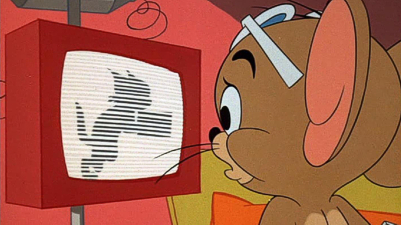
Regular readers will know that I’ll usually champion for both “open matte” and widescreen versions to be included, but unlike Disney, who always intended the future of his films to be on television, these cartoons were so very clearly framed for a wider image that when viewing the open matte editions, there is often nothing but wasted space. Nothing is lost in presenting these cartoons as originally shown in widescreen, and indeed the very decent prints (some of the finest of all the T&J offerings I have seen on DVD) make this feel like a very contemporary experience. So rest assured that The Chuck Jones Collection presents the films as they were intended to be seen and how they were framed by Chuck and company, and though they may be slightly less frantic and not as fast-paced, the cartoons look as good as possible here, retaining their film inheritance of some nicks and grain, but not coming over as too saturated or compressed.
Scratch Tracks:
Presented in their original mono mixes, the sound is uniformly solid across all of the cartoons, with many of them having the illusion of a real presence across the front channels. Indeed, some of them feature sound effects of such clarity that had I not known better I might have reasoned that they were newly mixed in, but a quick check with the original LD reminded me that the sound was just as exceptional there too. English, French and Portuguese dubs are all bundled in, as are English and Portuguese subtitles, though sadly not for the bonus material.
Final Cut:
Fluidly animated, funny, and expanding on the original potential of the characters, many of the Chuck Jones Tom & Jerry shorts feel fresh and still contemporary. They are a different take on the cat and mouse to be sure, but in mixing the formula a little, Jones revitalised the series and stopped it from outliving its welcome, especially coming after the lacklustre Deitch cartoons. Treating Tom and Jerry as almost human characters, like Bugs, Daffy and Wile E Coyote, enabled the animators to place them in new situations rather than confine them to just mostly chasing around the house, though the handful of future-set films possibly take it a little too far and lose a little of what we love about the characters. But in the main, Chuck Jones used the series to keep his hand in with full theatrical animation and ended up delivering a selection of cartoons that, while they never quite feel part of the traditional series, never emerge as cheap knock-offs, retaining their own feel and respect for the treatment of the characters.
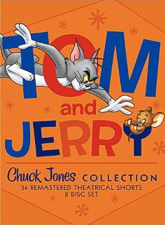 | ||
 [1] [1] |
- [Image]: http://www.amazon.com/exec/obidos/ASIN/B001U3N3QY/animatedviews-20
Source URL: https://animatedviews.com/2009/tom-and-jerry-chuck-jones-collection-dvd/